Where are the world’s reserves going?
More on:
In my post "has the US outsourced creative thinking about external adjustment to France," I noted that purchases of Treasuries by central banks have fallen off - even though global reserve accumulation has not fallen off.
Consider this graph, which compares the sum of the increase in reserves over the past four quarters with central bank purchases of Treasuries over the same time frame. Central bank demand for Treasuries - according to this measure - peaked last fall.
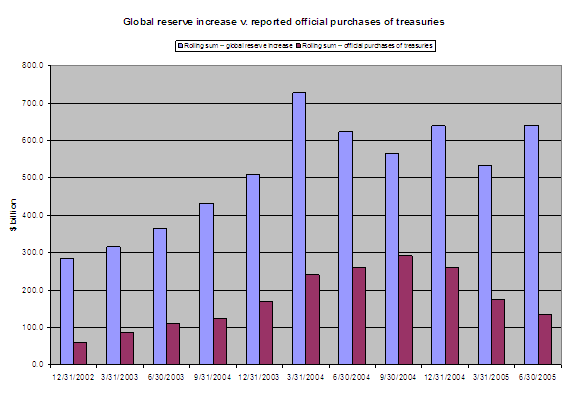
Continues
The quarterly data tells a similar story. Quarterly reserve growth has been strong since q4 2004 even without any intervention from the Bank of Japan. But demand for Treasuries has fallen off. I estimated central bank demand in q2 using the data that the Treasury releases; the actual data in the BEA may be a bit different - and I estimated global reserve accumulation in q2 using the IMF data through May, and the data various central banks have released.
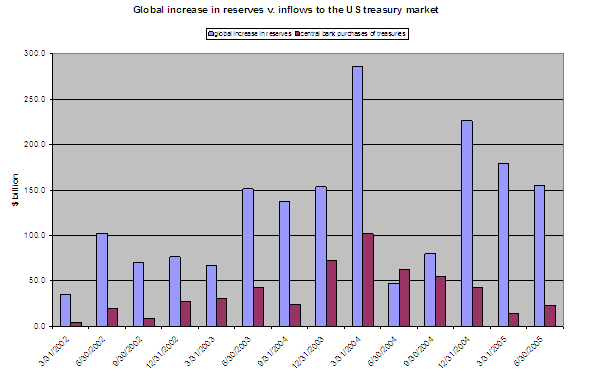
So what is going on? Part of the answer is that Japan is no longer adding to its reserves. Other countries - China, Malaysia, India, Russia and the other oil exporters - are still adding to the reserves rapidly. That is keeping the increase in global reserves at around $600 billion a year, maybe a bit higher.
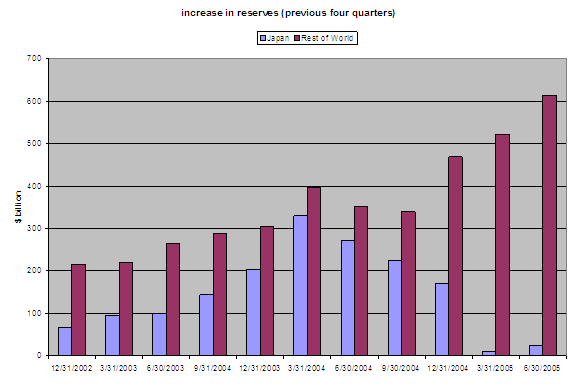
But the countries now adding to their reserves don't invest in Treasuries in the way that Japan did - or at least don't invest in Treasuries in ways that show up in the US data.
Consider the close correlation between the increase in the BOJ's holdings of securities of all types (dollar, euro, won, you name it) - the blue bar in the following graph -- and overall central bank purchases of treasuries - the red line the following graph.
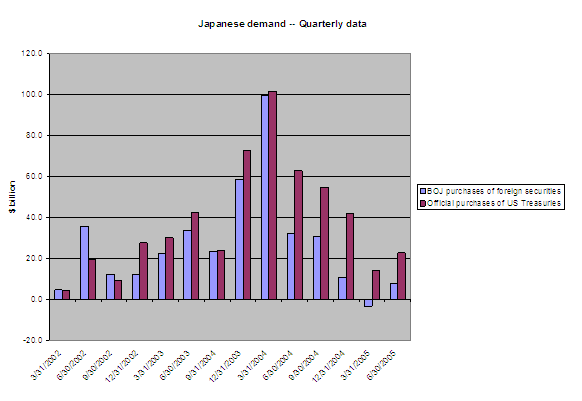
China certainly seems to invest far less of its reserves in Treasuries than the Bank of Japan, and far more in US agencies and US corporate debt. But its total purchases of US debt (recorded purchases) have only been about 40% of its increase in reserves in 2004 and so far in 2005. That leaves a lot for other things - whether euros, pounds, onshore dollar bank accounts, offshore dollar bank accounts or purchases of US debt that do not show up in the US data.
That story holds more broadly. If data on limited central bank demand for Treasuries is accurate, foreign central banks are now investing more in other assets than they ever have before. The blue line in the next graph shows a rolling four quarter total of central bank purchases of Treasuries. The redline shows the gap between my estimate of central bank reserve accumulation (my estimate is based on the imf data, but is adjusted roughly for valuation effects) and their purchases of Treasuries. In other words, the red line represents the sum central banks have available to purchase all other assets. That total is as high as it has ever been.
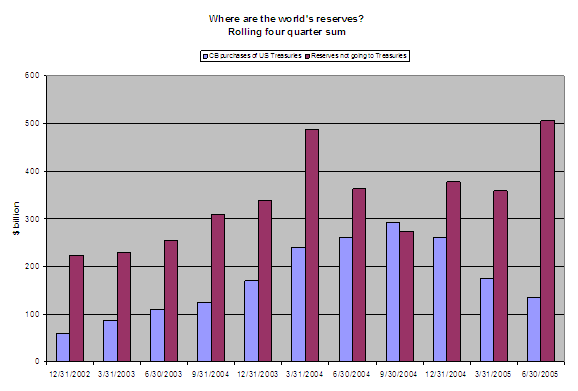
We know happened in q1 2004 with a large chunk of the increase in reserves that did not go into treasuries. Japan added a ton of money to its bank accounts, and used those funds to buy treasuries in q2 and q3. That is clearly not the story right now. Something else is going on ... what exactly though remains something of a mystery.
According to the TIC, central bank purchases of US agencies and US corporate debt over the last four quarters $45 billion of the gap in the last four quarters. According to the BEA, "onshore" dollar denominated central bank deposits have increased by $55 billion over the past four years. Those flows combine to cut the "red" line down from around $500 billion to $400 billion. That is still an impressive sum. To me, it is implausible that all of the "gap" - the $400 billion - is going into non-dollar reserves. The implied flows into the eurozone and the UK just seem too large.
What conclusions would I draw?
First, the overall impact of central bank reserve increases on global markets is almost as big as it was in q1 of 2004. Central banks have been adding to the reserves at an exceptional rate since the fourth quarter of 2004.
Second, central bank purchases are having a direct impact on a broader range of markets than they once did. In their own way, I suspect central banks are reaching for yield just like private investors.
Third, I wonder if the US inflow data still provides a useful estimate of the scale of central bank financing of the US. I don't find it plausible that central banks have invested a bit over $250 b in the US over the past four quarters (the BEA data suggests central bank inflows into all US markets were $280b - the BEAs estimate of inflows into "other US government securities - i.e. Agencies - are a bit higher than in the TIC data), and $350-400 billion in other reserve currencies. That implies a bit more diversification than I find plausible -- given the enormous US need for financing and given the scale of the implied inflows into the eurozone, which does not have a comparable need for financing. The only way the global flow of funds adds up is if every euro in official inflows to the eurozone is offset by a euro of outflows from private investors. That certainly happens; I just doubt it explains the full gap between recorded inflows from central banks into the US and known reserve accumulation.
Put differently, if that kind of diversification has already taken place, many of the concerns Nouriel and I expressed (along with Barry Eichengreen) about reverse diversification are misplaced. At a minimum, if that kind of diversification took place, we all at least failed to specify the real issue correctly. Diversification may not be the entire issue - if central banks buy tons of euros, they will drive down euro rates to point where private investors find dollar returns attractive (at least in some circumstances). The real issue is the pace at which central banks are adding to their reserves.
Fourth, the available data makes assessing the real impact of central banks on global markets next to impossible. We know - I think -- that they are having a bigger than suggested by recent US data. But the available data does not allow us to track the kinds of assets central banks are buying, or provide a detailed picture of precisely how are helping to finance US deficits.
Fifth, a bit more transparency from the world's central banks - as Ted Truman suggests - would be useful. Asian central bankers traditionally have wanted hedge funds to report their positions. Yet they rather clearly are reluctant to report their own (now very large) positions.
More on:
 Online Store
Online Store
